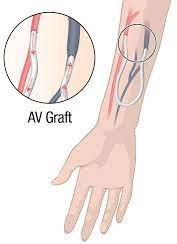After the insertion of an arteriovenous graft (AVG) in the right forearm, a patient complains of pain and coldness of the right fingers. Which action should the nurse take?
Teach the patient about normal AVG function.
Elevate the patient's arm on pillows to above the heart level.
Remind the patient to take a daily low dose aspirin tablet
Report the patient's symptoms to the health care provider.
The Correct Answer is D
Pain and coldness in the fingers following AVG placement can indicate impaired blood flow or compromised circulation to the hand. This may be due to complications such as thrombosis (clot formation), graft malfunction, or decreased arterial perfusion. These symptoms should be taken seriously and promptly communicated to the healthcare provider.
The healthcare provider needs to evaluate the patient's symptoms, assess the AVG, and determine the appropriate course of action. Prompt intervention can help prevent further complications and ensure adequate blood flow to the fingers.

Nursing Test Bank
Naxlex Comprehensive Predictor Exams
Related Questions
Correct Answer is C
Explanation
Hemoglobin A1C is a blood test that provides an average blood glucose level over the past 2-3 months. Regular monitoring of A1C levels helps to assess the effectiveness of lifestyle modifications and treatment plans and guides adjustments in management if necessary.
Daily exercise is another essential aspect of managing pre-diabetes. Regular physical activity helps improve insulin sensitivity, promotes weight management, and reduces the risk of developing type 2 diabetes. The nurse should educate patients on the importance of incorporating physical activity into their daily routine and provide recommendations on suitable exercise types and durations.
While other options may be relevant for patients with diabetes, they are not specifically tailored to pre-diabetes, which is a condition where blood glucose levels are higher than normal but not yet meeting the criteria for diabetes.
Hypoglycemia and injection site infection are more relevant concerns for individuals with diabetes who require insulin or other medications to manage their blood sugar levels. Increasing carbohydrate intake and administering insulin are not appropriate recommendations for pre-diabetes management, as they can contribute to elevated blood glucose levels.
Correct Answer is B
Explanation
Acute adrenal insufficiency, also known as adrenal crisis, is characterized by low levels of adrenal hormones, particularly cortisol. One of the primary manifestations of adrenal insufficiency is electrolyte imbalance, specifically hyponatremia (low sodium) and hyperkalemia (high potassium). Inadequate cortisol levels can lead to impaired sodium reabsorption in the kidneys, resulting in sodium loss and low serum sodium levels.
When the patient receives appropriate therapies for acute adrenal insufficiency, such as administration of glucocorticoids (e.g., hydrocortisone), the cortisol levels begin to normalize. As a result, the impaired sodium reabsorption improves, leading to an increase in serum sodium levels.
Whether you are a student looking to ace your exams or a practicing nurse seeking to enhance your expertise , our nursing education contents will empower you with the confidence and competence to make a difference in the lives of patients and become a respected leader in the healthcare field.
Visit Naxlex, invest in your future and unlock endless possibilities with our unparalleled nursing education contents today
Report Wrong Answer on the Current Question
Do you disagree with the answer? If yes, what is your expected answer? Explain.
Kindly be descriptive with the issue you are facing.
